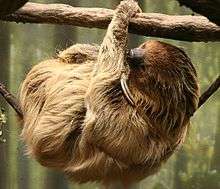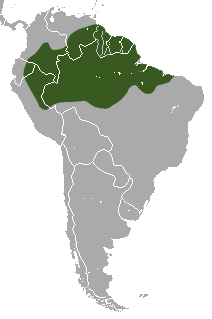Linnaeus's two-toed sloth
Linnaeus's two-toed sloth (Choloepus didactylus), also known as the southern two-toed sloth, unau, or Linne's two-toed sloth is a species of sloth from South America, found in Venezuela, the Guyanas, Colombia, Ecuador, Peru, and Brazil north of the Amazon River. There is now evidence suggesting the species' range expands into Bolivia.[4]
| Linnaeus's two-toed sloth[1] | |
|---|---|
 | |
| Scientific classification | |
| Kingdom: | Animalia |
| Phylum: | Chordata |
| Class: | Mammalia |
| Order: | Pilosa |
| Family: | Choloepodidae |
| Genus: | Choloepus |
| Species: | C. didactylus |
| Binomial name | |
| Choloepus didactylus | |
 | |
| Linnaeus's two-toed sloth range | |
| Synonyms | |
|
Bradypus didactylus Linnaeus, 1758 | |
Phylogeny
Sloths belong to the order Pilosa, which also includes anteaters. They belong to the super order Xenarthra, which includes the Cingulata. Xenarthra are edentate or toothless. They lack incisors and have a large reduction in number of teeth with only four to five sets remaining including canines.[5]
Modern sloths are divided into two families based on the number of toes on their front feet, Megalonychidae and Bradypodidae. Linnaeus's two-toed sloth and Hoffmann's two-toed sloth (Choloepus hoffmanni) belong to the family Megalonychidae, which included extinct ground sloths.[6]
Morphology
Choloepus didactylus are larger than three-toed sloths. They have longer hair, bigger eyes, and their back and front legs are more equal in length.[7] Their ears, hind feet and head are generally larger than Bradypodidae. They do however have a shorter tail.[8] Their shoulder height, the height from the shoulder blade to the tips of the claw is longer than three-toed sloths, indicating longer arms.[8]
The species has relatively few teeth; it has four to five sets including canines and lacks incisors. The teeth lack enamel, consisting only of two layers ever-growing dentin.[5] Supernumerary teeth have occasionally been observed, but this has been reported in almost all mammalian orders.[5]
Ecology
C. didactylus is a solitary, nocturnal and arboreal animal, found in rainforests. The two-toed sloth falls prey to wild cats such as the ocelot and jaguar as well as large birds of prey such as the harpy and crested eagles. Predation mainly occurs when the sloth descends to the ground in order to defecate or change trees.[6] Anacondas have also been known to hunt sloths.[6] It is able to swim, making it possible to cross rivers and creeks, but maybe also making it more available to a predator like an anaconda.
Two-toed sloths live in ever-wet tropical rainforests that are hot and humid. They tend to live in areas where there is a lot of vine growth so they can easily travel from tree to tree in the canopies of the forests.[6] They mainly eat leaves, but there is lacking data on the extent of their diet due to their nocturnal lifestyle and camouflage.[6]
See also
- Emmons, Louise H.; Feer, François (1997-09-02). Neotropical rainforest mammals. A field guide (2nd ed.). Chicago: University of Chicago Press. p. 45. ISBN 978-0-226-20721-6. OCLC 44179508.
References
- Gardner, A.L. (2005). "Order Pilosa". In Wilson, D.E.; Reeder, D.M (eds.). Mammal Species of the World: A Taxonomic and Geographic Reference (3rd ed.). Johns Hopkins University Press. p. 101. ISBN 978-0-8018-8221-0. OCLC 62265494.
- Chiarello, A; Plese, T. (2014). "Choloepus didactylus". IUCN Red List of Threatened Species. IUCN. 2014: e.T4777A47439542. doi:10.2305/IUCN.UK.2014-1.RLTS.T4777A47439542.en. Retrieved 6 November 2019.
- Linnæus, Carl (1758). Systema naturæ per regna tria naturæ, secundum classes, ordines, genera, species, cum characteribus, differentiis, synonymis, locis. Tomus I (in Latin) (10th ed.). Holmiæ: Laurentius Salvius. p. 35. Retrieved 23 November 2012.
- Trinca, Cristiano Trapé; Palmeira, Francesca Belem Lopes; de Sousa e Silva Júnior, José (2006-05-01). "A Southern Extension of the Geographic Distribution of the Two-Toed Sloth, Choloepus didactylus (Xenarthra, Megalonychidae)". Edentata. 7: 7–9. doi:10.1896/1413-4411.7.1.7. ISSN 1413-4411.
- McAfee, Robert K.; Naples, Virginia L. (2012-01-01). "NOTICE ON THE OCCURRENCE OF SUPERNUMERARY TEETH IN THE TWO-TOED SLOTHS Choloepus didactylus AND C. hoffmanni". Mastozoología Neotropical. Retrieved 2015-11-20.
- Adam, Peter J. (December 1999). "Mammalian Species Choloepus didactylus". American Society of Mammalogists.
- Stewart, Melissa (November–December 2004). "At the Zoo: Slow and Steady Sloths". Zoogoer. Smithsonian Institution. Archived from the original on 7 June 2011. Retrieved 23 November 2012.
- Richard-Hansen, C.; Vié, J.-C.; Vidal, N.; Kéravec, J. (1999-04-01). "Body measurements on 40 species of mammals from French Guiana". Journal of Zoology. 247 (4): 419–428. doi:10.1111/j.1469-7998.1999.tb01005.x. ISSN 1469-7998.
Gallery
 1883 painting
1883 painting Choelopus didactylus at Buffalo Zoo
Choelopus didactylus at Buffalo Zoo Sloth & baby, caught at Leticia, Colombia
Sloth & baby, caught at Leticia, Colombia
| Wikispecies has information related to Choloepus didactylus |
| Wikimedia Commons has media related to Choloepus didactylus. |
